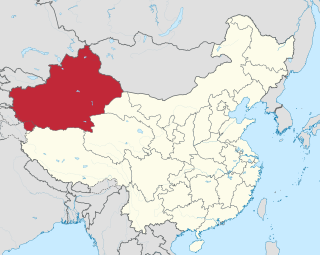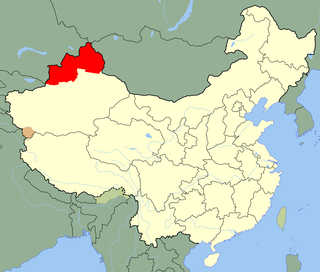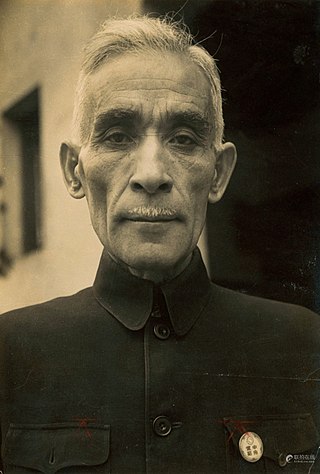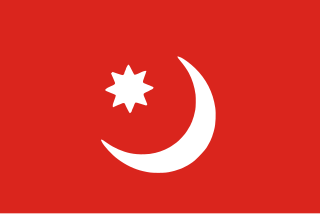Uyghurlar (in English: The Uyghurs) is a book by historian Turghun Almas on the history of the "6,000 year history" of the Uyghur ethnic group of the Xinjiang region of China. [1] It was published in the People's Republic of China in 1989, at a high point of liberalization of academic freedom and ethnic minority policy in China. [1] It was one of the books of the period that presented an "alternative Uyghur history", based on Soviet historiography during the Sino-Soviet split, that advanced the thesis that the Uyghurs are the historical owner of Xinjiang and should have an independent state. [2] It was also one of the first books to publicize the term East Turkestan, which suggests a kinship to a "West Turkestan" in the independent Central Asian states. [2] In contrast to the official Chinese history of Xinjiang, which states that the region was an integral part of China since the Han dynasty, [3] the book takes a nationalist view, saying that many "Uyghur" states throughout history were independent of or even dominant over, China. [4]
Almas had used references from both Chinese and Soviet sources to prove various theories, including that the Tarim mummies indicate that the Uyghurs were "older than Chinese civilization itself", and that the Uyghurs invented the compass, gunpowder, papermaking, and printing. It concluded, "If the Jews could reclaim their homeland after 3,000 years, the Uyghurs should be able to reclaim their homeland after 3,000 to 6,000 years". [5] In response to the book's growing popularity among Uyghurs, in February 1991, the Xinjiang CPC Propaganda Department and the Xinjiang Academy of Social Sciences jointly organized an academic conference to discuss the historical claims in Uyghurlar, as well as those in two of Almas' other books. More than 140 historians, ethnographers, archaeologists, and literature specialists from different ethnic groups in Xinjiang and Beijing scrutinized the research of the book, concluding that it "distorted and falsified history". [3] The government soon publicized a pamphlet called "One Hundred Mistakes of Turghun Almas' Uyghurlar" to publicize the book's historical flaws, which had the opposite effect of increasing interest in the book. [6] The book was banned and Almas was said to be placed under "virtual house arrest" in Urumqi.

The Uyghurs, alternatively spelled Uighurs, Uygurs or Uigurs, are a Turkic ethnic group originating from and culturally affiliated with the general region of Central and East Asia. The Uyghurs are recognized as native to the Xinjiang Uyghur Autonomous Region in Northwest China. They are one of China's 55 officially recognized ethnic minorities. The Uyghurs are recognized by the Chinese government as a regional minority and the titular people of Xinjiang.

East Turkestan is a loosely defined geographical and historical region in the western provinces of the People's Republic of China, which varies in meaning by context and usage. The term was coined in the 19th century by Russian Turkologists, including Nikita Bichurin, who intended the name to replace the common Western term for the region, Chinese Turkestan, which referred to the Tarim Basin in southern Xinjiang or Xinjiang as a whole during the Qing dynasty. Beginning in the 17th century, Altishahr, which means "Six Cities" in Uyghur, became the Uyghur name for the Tarim Basin. Uyghurs also called the Tarim Basin "Yettishar," which means "Seven Cities," and even "Sekkizshahr", which means "Eight Cities" in Uyghur. Chinese dynasties from the Han dynasty to the Tang dynasty had called an overlapping area the "Western Regions". The parts of this area conquered by the Manchu Qing dynasty were termed "Xinjiang" from the 18th century on.

The Turkic Islamic Republic of East Turkestan (TIRET) was a short-lived breakaway Islamic republic founded on 12 November 1933. It was centred on the city of Kashgar in West of Xinjiang province (1912–1992) in what is today a part of Xinjiang Uyghur Autonomous Region. Sometimes referred to simply as the East Turkestan Republic (ETR), it was primarily the product of an independence movement of the Uyghur population living there and more broadly of Turkic-ethnicity in character, including Kyrgyz and other Turkic peoples in its government and its population.

Turghun Almas was a Uyghur historian and poet born in Kashgar. He was criticized for his "support for ethnic nationalist separatists" by Wang Lequan. He was jailed from 1943 to 1946 and again from July 1947 to April 1949 for his political activities. In 1950 he became an editor for the Azadliq (Freedom) newspaper.

The East Turkestan independence movement is a political movement that seeks the independence of East Turkestan, a large and sparsely-populated region in northwest China, as a nation state for the Uyghur people. The region is currently administered as a province-level subdivision of the People's Republic of China (PRC), under the official name Xinjiang Uygur Autonomous Region (XUAR). Within the movement, there is widespread support for the region to be renamed, since "Xinjiang" is seen by independence activists as a colonial name. "East Turkestan" is the best-known proposed name as it is the historical geographic name of the region and the name of the two independent states that briefly existed in the region in the first half of the 20th century.

The East Turkestan Republic (ETR) was a short-lived satellite state in northwest Xinjiang, between November 12, 1944, and December 22, 1949. To differentiate it from the First East Turkestan Republic (1933–1934) it is often described as the SecondEast Turkestan Republic, although the adjective Second was never an official part of its name.

Muhammad Amin Bughra, sometimes known by his Han name Mao Deming and his Turkish name Mehmet Emin Buğra; 1901–1965), was a Uyghur Muslim leader who planned to set up a sovereign state, the First East Turkestan Republic. Muhammad Amin Bughra was a Jadidist.

Xinjiang is historically consisted of two main geographically, historically, and ethnically distinct regions with different historical names: Dzungaria north of the Tianshan Mountains; and the Tarim Basin south of the Tianshan Mountains, currently mainly inhabited by the Uyghurs. They were conquered by the Qing dynasty in the 18th century, and after the Dungan Revolt (1862–1877) the Qing reconquered both regions and integrated them into one province named Xinjiang in 1884.
Terrorism in China refers to the use or threatened use of violence to effect political or ideological change in the People's Republic of China. The definition of terrorism differs among scholars, between international and national bodies and across time and there is no legally binding definition internationally. In the cultural setting of China, the term is relatively new and ambiguous.

Saifuddin Azizi, also known as Seypidin Azizi, Saif al-Dīn ʿAzīz, Saifuding Aizezi and Saifuding, was the first chairman of the Xinjiang Uyghur Autonomous Region of the People's Republic of China.

Xinjiang, officially the Xinjiang Uygur Autonomous Region, is an autonomous region of the People's Republic of China (PRC), located in the northwest of the country at the crossroads of Central Asia and East Asia. Being the largest province-level division of China by area and the 8th-largest country subdivision in the world, Xinjiang spans over 1.6 million square kilometres (620,000 sq mi) and has about 25 million inhabitants. Xinjiang borders the countries of Mongolia, Russia, Kazakhstan, Kyrgyzstan, Tajikistan, Afghanistan, Pakistan and India. The rugged Karakoram, Kunlun and Tian Shan mountain ranges occupy much of Xinjiang's borders, as well as its western and southern regions. The Aksai Chin and Trans-Karakoram Tract regions, both administered by China, are claimed by India. Xinjiang also borders the Tibet Autonomous Region and the provinces of Gansu and Qinghai. The most well-known route of the historic Silk Road ran through the territory from the east to its northwestern border.

The Ili Rebellion was a Uyghur separatist movement backed by the Soviet Union against the Kuomintang government of the Republic of China in 1944. After the start of the rebellion, the rebels established the Provisional Government of the Second East Turkestan Republic in 1944. The Ili Rebellion was the start of the East Turkistan National Liberation Revolution, also known as the Three Districts Revolution, which lasted from 1944 to 1949.

The Kumul Rebellion was a rebellion of Kumulik Uyghurs from 1931 to 1934 who conspired with Hui Chinese Muslim Gen. Ma Zhongying to overthrow Jin Shuren, governor of Xinjiang. The Kumul Uyghurs were loyalists of the Kumul Khanate and wanted to restore the heir to the Khanate and overthrow Jin. The Kuomintang wanted Jin removed because of his ties to the Soviet Union, so it approved of the operation while pretending to acknowledge Jin as governor. The rebellion then catapulted into large-scale fighting as Khotanlik Uyghur rebels in southern Xinjiang started a separate rebellion for independence in collusion with Kirghiz rebels. Various groups rebelled, and were not united. The main part of the war was waged by Ma Zhongying against the Xinjiang government. He was supported by Chiang Kai-shek, the Premier of China, who secretly agreed to let Ma seize Xinjiang.

Masud Sabri, also known as Masʿūd Ṣabrī, was an ethnic Uyghur politician of the Republic of China who served as the Governor of Sinkiang during the Ili Rebellion. He received education at Kulja and Istanbul and was a Pan-Turkist. Chiang Kai-shek appointed him the first non-Han governor of any Chinese province during the twentieth century.
The history of the Uyghur people extends over more than two millenia and can be divided into four distinct phases: Pre-Imperial, Imperial, Idiqut, and Mongol, with perhaps a fifth modern phase running from the death of the Silk Road in AD 1600 until the present.

The Xinjiang conflict, also known as the East Turkistan conflict, Uyghur–Chinese conflict or Sino-East Turkistan conflict, is an ongoing ethnic geopolitical conflict in what is now China's far-northwest autonomous region of Xinjiang, also known as East Turkistan. It is centred around the Uyghurs, a Turkic ethnic group who constitute a plurality of the region's population.

Migration to Xinjiang is both an ongoing and historical movement of people, often sponsored by various states who controlled the region, including the Han dynasty, Qing dynasty, Republic of China and People's Republic of China.

Christianity is a minority religion in Xinjiang, an autonomous region of China, formerly known as Chinese Turkestan. The dominant ethnic group, the Uyghur, are predominantly Muslim and very few are known to be Christian. Christianity in Xinjiang is the religion of 1% of the population according to the Chinese General Social Survey of 2009. According to Asia Harvest, estimates from 2020 suggest that of the entire population (24,992,119) about 3.77% is Christian (942,897).

Tunganistan, also called Dunganistan, was an independently administered region in the southern part of the Chinese province Xinjiang from 1934 to 1937, contemporaneous to the Chinese Civil War in China proper. The name "Tunganistan" was coined by the Austrian Mongolia expert Walther Heissig. The territory included the oases of the southern Tarim Basin and the centre of the region was Khotan. Tunganistan was surrounded on three sides by troops loyal to Xinjiang governor Sheng Shicai and to the south by the Tibetan Plateau.
Uyghur nationalism is a nationalist movement which asserts that the Uyghur people, an ethnic minority in China, are a distinct nation. Uyghur nationalism promotes the cultural unity of the Uyghur people, either as an independent group or as a regional group within a larger Chinese nation.














